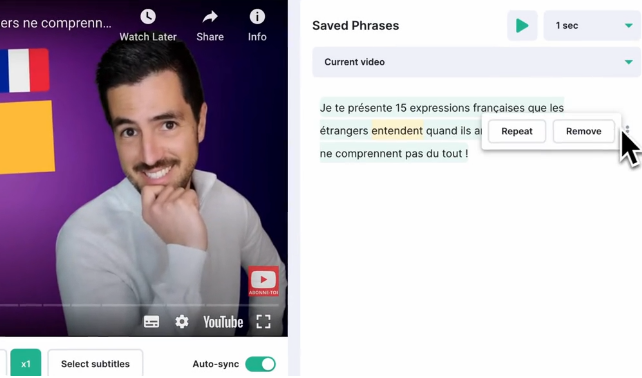How Teachers Can Use AI to Improve Language Lessons
Read other articles:
Back to posts
Table of Contents

Over 180 million people already use ChatGPT and a proportion of these will, no doubt, learn a language with ChatGPT at some point.
In a couple of months, that figure may seem very outdated because the rate of uptake of ChatGPT and AI is quite astonishing.
Many learners use artificial intelligence (AI) without knowing it as it’s increasingly becoming “baked in” to the engines that drive app functionality. Even if it’s just to check out the meaning of a word or phrase, AI is becoming the go-to technology for language learners outside of the classroom.
And, increasingly, AI will enter the classroom as another tool that teachers can use to more effectively teach foreign languages, helping them improve lessons and learning outcomes as well as managing some of the administrative side of the role.
We’ll take a look at the following:
- Is AI a threat to teachers?
- What are the big benefits of AI for language teachers?
– More personalized and engaging content
– Language learning anytime, anywhere
– Instant monitoring and feedback
– Low-anxiety learning
– Help with designing curriculums
- 5 ways to bring AI into the language classroom
– Generate personalized “textbooks”
– Help students interact with “native speakers”
– Bring context to learning situations
– Easily generate engaging quizzes and games
– Provide personalized progress reports
- Language teachers and AI can be good friends…
Is AI a threat to teachers?
Some teachers view AI as a threat to their profession. They are worried that AI will replace them.
But people said the same about the Internet. Just because learners can sign up for online courses and Google can translate foreign language phrases hasn’t made all language teachers redundant. It’s simply changed how they work.
Humans generally adapt to technology well. AI is already a key component of many sectors, such as ecommerce, FinTech, training and marketing — and it has already started to enter education.
The “AI factor” seems inevitable and is not going away any time soon. Embracing the benefits of AI and harnessing it as a language-teaching aid can help you stay ahead of the curve. You may just need to modify your approach to language teaching a little.
After all, if you love teaching but hate marking and grading work, an AI-based bot might be able to look after that task more effectively while you focus on more engaging language interactions with students and designing coursework.
Ultimately, AI does not have the emotional intelligence required to replace language teachers. Learning experiences are simply more profound when they are underpinned by emotional experiences as well as mental stimulation.

What are the big benefits of AI for language teachers?
So, how can teachers use AI not only to improve outcomes for the language learners under their wings but also to make their own lives easier?
More personalized and engaging content
AI allows a greater degree of personalization of learner content than traditional textbooks or even many online courses. That comes from its data-collection abilities.
AI can help teachers collect and analyze useful data about learners’ abilities and preferences so that courses can be more tailored and effective. Learners can learn in their preferred styles, at their own pace, with content that engages them and with their own goals in mind. This naturally boosts engagement and is highly likely to improve learning outcomes.
Language learning anytime, anywhere
AI-based apps provide learning opportunities that extend well beyond the classroom so that the keenest learners can study anytime, anywhere. Immersion in the target language is easier when assistance is available at your fingertips (on smartphones and tablets).
Teachers can use class time to set up other tasks that language students can accomplish out of class using the tech.

Instant monitoring and feedback
AI provides instant monitoring and feedback when you (as the teacher) are not around. Correcting mistakes and assessing work is an important part of the language-teaching process that AI can often handle.
The obvious flaw in this plan? What if the information from the AI bot is inaccurate so mistakes are incorrectly corrected?
That does happen but teachers do make mistakes too, let’s not forget. Nobody is claiming that AI is perfect. Its accuracy will improve and, with human sciences (such as language studies), the ceiling for accuracy is high. Languages are essentially constructed from a set of rules that machines can learn.
Low-anxiety learning
If learners feel anxious when put on the spot in a classroom, as is common, they are less likely to fall in love with learning that language. With flashcards and many traditional teaching methods, the need for learners to present or talk to the class (even when they don’t feel ready) is common. This may be a breeze for the most gifted students but others freeze — and fear is not very conducive to effective learning.
AI can provide a safe, low-anxiety learning environment with no fear of embarrassment. More learners will feel comfortable with this.

Help with designing curriculums
If part of your responsibility as a language teacher is designing the curriculum, AI may be able to suggest how to make lessons more effective.
Whether the learning process is in a real or virtual classroom, if there are weaknesses in the lesson plans you suggest or in how a question is phrased in a test, for instance, AI can flag it for you and suggest alternatives.
5 ways to bring AI into the language classroom
Students are already using AI to learn foreign languages themselves. If teachers don’t bring AI into the classroom, their students likely will (on their phones).
So, how can you bring this desire to use the tech to learn a language into the classroom productively? Here are a few ideas…
1. Generate personalized “textbooks”
Personalized textbooks present the target learning points according to the learning preferences of each student.
For instance, three groups of students are learning Spanish. We know that Group A loves football, Group B are big fans of dance music and Group C are video game fanatics.
With AI, each group can learn the endings of the verbs jugar/to play in their preferred contexts with personalized content, maybe even including their idols in the learning content.
An AI system can help you generate personalized textbooks that are more engaging for learners based on the data you collect on each student. Textbooks can be tailored for particular schools, courses, groups of students or even individual students.
Each student can progress at their own pace, with the teacher monitoring the process, correcting mistakes and providing all-important guidance as needed.
2. Help students interact with “native speakers”
Stephen Krashen and many other language experts believe that the only way to learn a language effectively is by being taught in the native language.
This instantly excludes many of the online language courses and learning apps (even the AI-based language apps) that provide instruction in the learner’s native language rather than the target language.
Conversational language bots can be a fun addition to a language lab, allowing students to engage at their own speed and difficulty level with AI-based “native speakers” in a low-anxiety environment. These bots are being improved and are soon likely to be commonplace in language classrooms.
AI chatbots can familiarize themselves with users’ speech and text patterns over time. Interactive conversations with chatbots are already a “thing” and are likely to become more so in the coming years.
3. Bring context to learning situations
Vocabulary teaching often fails because limited context is provided. This makes it unmemorable as well as being very uninteresting.
It’s amazing how many “language learning courses” are based almost purely on memorizing vocabulary and grammar rules. A quick scan of YouTube will show videos and videos of vocab lists.
Instead, learning phrases in context with visual and audio signals is the best way to boost learning. The combination of video and AI is especially powerful for language teachers to use — either in the classroom or as tasks set for students outside the classroom to work on in their own time.
Combining video and AI provides learners with the closest thing to language immersion with native speakers short of actually “being there”. Language learners can watch movies, TV programs, documentaries and other videos on topics of interest and learn new phrases, vocab, sentence structures, expressions and idioms. The visual and audio context provided helps cement the learning.

The best AI-based YouTube video learning tool currently available is a free Chrome extension, which takes subtitled video in the target language and translates it, allowing language learners to build personalized phrase and vocab libraries.
A video-AI combination like this is one of the most motivational, engaging and fun ways to learn a language. Teachers may want to start guiding language students on how to use it productively.
4. Easily generate engaging quizzes and games
How much time do you spend trying to spruce up lessons and make them more engaging and fun for language learners?
“Gamification” is part of everyday life for many young people. They have games on their phones, tablets, PlayStations, etc., etc. Bringing it into the classroom is a natural way to capture and hold attention.
AI can make the “gamification” process much easier. You can introduce one or more of the many language-learning apps out there that use AI (if your students don’t already know them).
Duolingo, Babbel, Memrise, Busuu … the list is almost endless and most of them have inbuilt quizzes, games, competitions and rewards to stimulate interest during the learning process.
Teachers can use the apps to generate new ideas or to help build targeted vocab for language learners.
Teachers can also use ChatGPT to generate targeted quizzes around certain learning points. You might prompt the ChatGPT chatbot with something like this:
“Create a short quiz in French followed by a multiple-choice reading comprehension test for intermediate level students to improve their knowledge of the verb ouvrir/to open.”
5. Provide personalized progress reports
AI can also help language teachers with the administrative side of the job.
As well as getting AI to set up and mark multiple-choice tests for students, for instance, you can also use the technology to provide a personalized progress report for students.
AI platforms can track how each learner is doing and provide data-driven insights into their progress. Their particular strengths and weaknesses can be identified and a profile built up of the most effective learning methods. This helps you further tailor materials for the student’s language-learning journey.
As well as aiding the teacher, it helps students track their own progress and stay motivated to reach realistic learning goals.

Language teachers and AI can be good friends…
Personalized learning, instant feedback, interaction with native speakers and the opportunity for greater language immersion are just a few of the attractions of AI for foreign language teachers and students.
Used effectively, language teachers can apply AI to make learning outcomes more effective, while also making their lives easier and freeing their time up for the teaching tasks they love doing and that require human interaction.
A final reminder that if you want to explore our AI-based learning tool for learning languages from YouTube videos, download our free Chrome extension here.
Read other articles:
Back to posts
